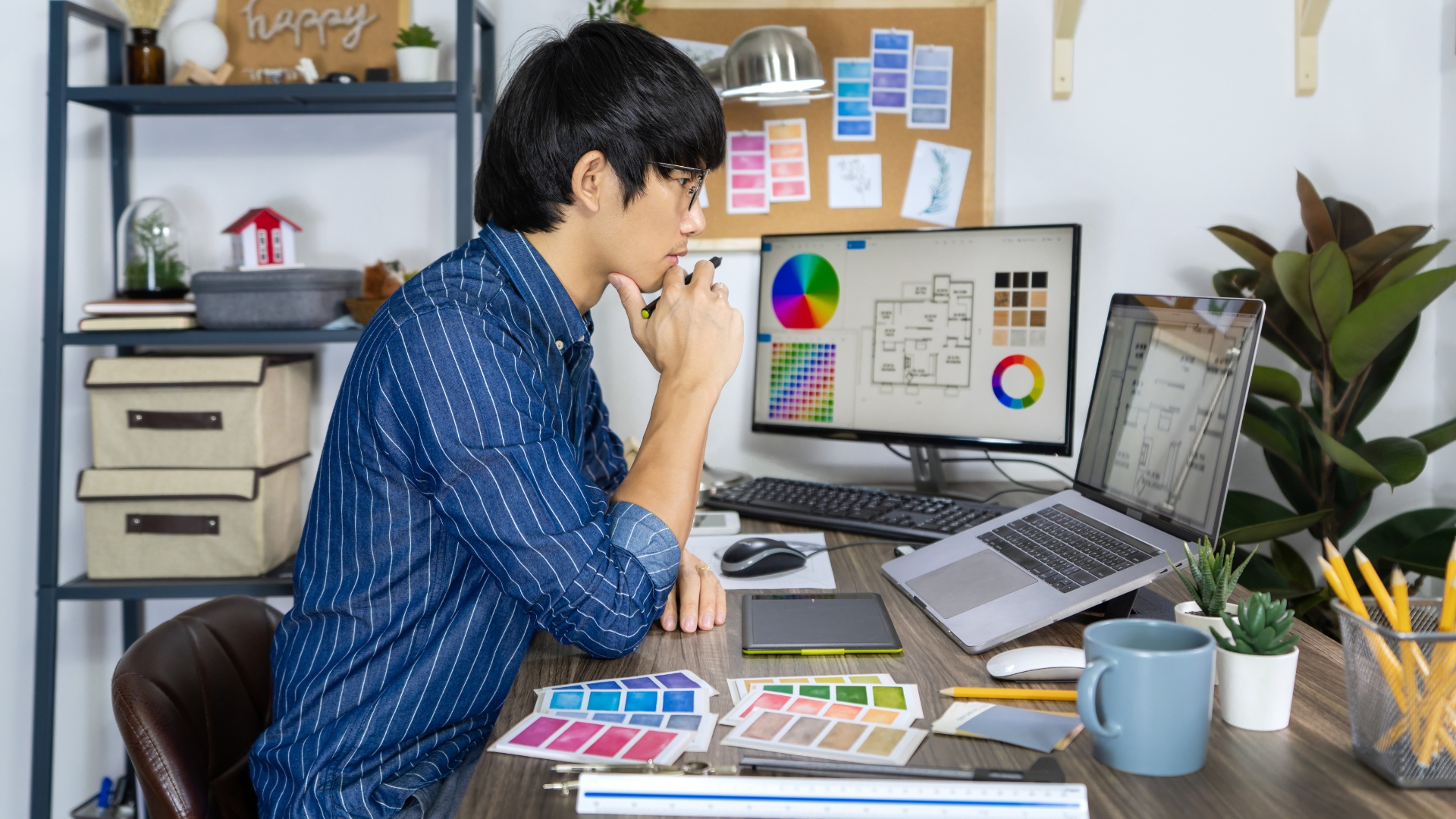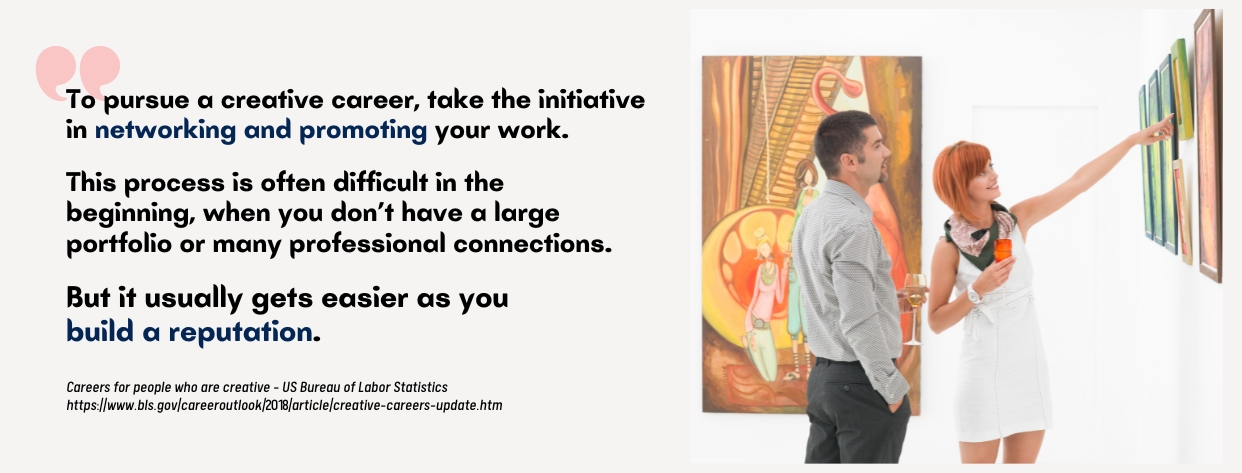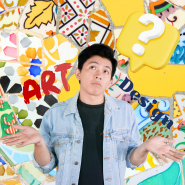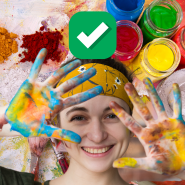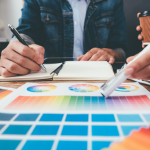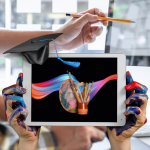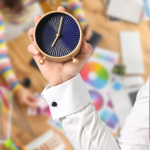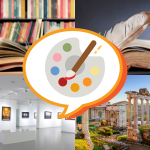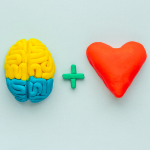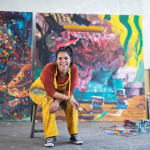Find Your Perfect School
Engaging in arts and design is an incredibly fulfilling and satisfying pursuit in life. It is an avenue for self-expression, creative fulfillment, and personal enjoyment. it is a viable career choice, too!
Many artists—including the most famous figures in the industry—face the challenge of society perceiving art as merely a hobby or a career with limited financial prospects.
For more information, see: Art and Design Degree and Career Guide
Certain skills are a must for a successful career in art and design. Such skills comprise both technical expertise and broader abilities that encourage artists and designers to innovate, thrive, and make a lasting impact on their chosen fields of art and design.
Let us start on this journey through the world of creativity and explore the skills that will shape the careers of artists and designers. Through cultivating and honing these ten art and design skills, individuals can position themselves for success in the dynamic art and design job market, opening doors to a wide range of rewarding and fulfilling career paths.
What is Art and Design?
Art and design comprise the imaginative human expression of emotions, ideas, and aesthetics!
All About Art
Art encompasses a vast array of mediums, ranging from conventional paintings and sculptures to contemporary digital creations and installations.
Art also permits individuals to investigate and interpret the world around them, provoking thought and eliciting profound emotions using their artistic skills.
What Design Does
Design, on the other hand, emphasizes functional creation with an eye toward usability. It involves shaping the form and function of objects, spaces, and experiences to improve our daily existence.
Art and design are both effective modes of communication and cultural reflection, which shape our understanding of the world and enrich our experiences.
Art and Design Career: Making the Choice
Deciding on a career in art and design provides creative individuals with numerous opportunities. This covers various fields of art and design, including graphic design, illustration, animation, interior design, and fashion design. Specific areas of these are advertisement, publication, films, entertainment, and fashion which are just some of the industries where professionals can find work.
Freelancing and entrepreneurship are viable career options for Art and Design graduates, as well, allowing artists and designers to exhibit their distinctive styles and serve a variety of clients.
With the expansion of technology and the digital landscape, there are innumerable opportunities to investigate, making art and design a dynamic and lucrative career option that essentially gives abstract ideas visual form.
Skills for Art and Design Career Success
While art and design may be synonymous with beauty and balance, the path to becoming part of this industry is no walk in the park! Indeed, carving out a career in the Art and Design field is a lot of work.
It takes a world of hard and soft skills to truly succeed as an artist or designer! The following are some of the most commonly expected attributes of someone aspiring to make a mark in the industry:
Technical Proficiency
One thing to note when entering the arts and design career – technical proficiency. To succeed in a career in graphic design, fine arts, or any field it is essential to possess a thorough understanding and knowledge of the necessary tools, methodologies, and media.
Also, to effectively navigate the intricate and multifaceted landscapes of their chosen field of work. Art and Design majors are expected to have these skills!
For instance, graphic designers in this field must be adept at utilizing design software such as the Adobe Creative Suite, Illustrator, and In Design which are commonly used in graphic and animation studios.
The level of one’s technical proficiency is of comparable significance in the area of fine arts. This would give the artist an advantage when it comes to having a graphic design career in any field of art and design.
Final word:
A mastery of technical skills allows artists to effectively convey their artistic expressions and bring their abstract ideas into visual form.
Creative Problem-Solving
Graphic designers, like creative artists, heavily depend on their ability to think creatively and solve problems in their everyday work. They frequently come across design challenges that demand innovative thinking to create visually striking and impactful solutions.
Artists need to find imaginative ways to capture the very purpose of a brand and translate it into a visually appealing and something that they would remember design that effectively conveys the desired message.
The ability to approach design challenges from fresh perspectives and deliver unique outcomes sets them apart from their peers. This is a valuable skill that helps the artist overcome limitations and deliver successful designs in the form of essential and decorative items and unique masterpieces!
Clients and employers highly value designers who can tackle complex problems and provide creative solutions that meet their specific needs.
Final word:
Creative problem-solving is a fundamental skill in graphic design or any artistic field, designers can navigate the dynamic and ever-evolving industry with confidence. They can approach design challenges as opportunities for growth and innovation, resulting in unique and impactful graphic designs that resonate with audiences and leave a lasting impression.
Visual Communication
The act of utilizing visual components to effectively convey a message, stimulate transformation, or elicit an affective response is known as visual communication. Artists who work in this field must effectively communicate their concepts, ideas, and emotions.
Visual communication entails comprehending and employing visual elements such as color, composition, typography, and imagery to create visually engaging pieces.
It is an important skill for artists as they create various marketing materials such as logos, advertisements, websites, and more. They must consider several factors to create visually appealing and impactful designs that effectively communicate the desired message.
Artists must use various visual components to communicate their artistic perspective to clients, manufacturers, and the general public.
Through adept integration of visual elements, graphic designers effectively convey the aesthetic, emotional tone, and storytelling aspects of their designs. They can create compelling visuals that effectively convey their intended message.
Final word:
Artists must understand their audience and culture. This understanding lets artists and designers tailor their work to the audience and effectively convey the message.
Adaptability
In arts and design, adaptability is vital. In a fast-paced and ever-evolving society, innovative equipment, techniques, and mediums must be embraced by artists and designers. Adaptability helps professionals stay current, explore new artistic avenues, and compete in a continuously changing industry.
This involves being open to learning, unlearning, and relearning. It requires a curious and proactive mindset, seeking out opportunities to expand one’s skill set and knowledge base. The pursuit of higher education, such as a master’s degree, can establish a firm basis for ongoing learning and flexibility within the realm of art and design.
Adaptability is a crucial skill as it allows them to effectively navigate fluctuations in the ever-growing society. It empowers professionals to explore new creative avenues, embrace interdisciplinary collaborations, and discover innovative solutions to artistic challenges.
The design career outlook remains promising for adaptable professionals. The current focus on sustainability, user-centric design, and the incorporation of technology has created numerous prospects for innovative individuals capable of adjusting to these constantly changing demands.
Final word:
The ability to remain flexible and adaptable is crucial for individuals pursuing careers in different fields of art and design. This attribute enables them to position themselves for success and flourish in a constantly changing and dynamic field.
Collaboration
Collaborating with fellow artists and designers is important to ensure a successful career in the art and design industry. Collaborative projects are a common practice in the creative industry, where artists and designers often work together with individuals, may it be clients, peers, and professionals from various fields.
Working with multimedia designers who have unique viewpoints and specialized knowledge will lead to a more varied and enhanced product. Being in a collaborative environment, artists and designers gain the benefits of synergistic effects resulting from shared ideas, mutually inspiring one another, and producing work that would exceed expectations of having the work done as one.
This plays a pivotal role in the creative process for artists and designers, particularly when working alongside art directors and digital designers. These individuals are recognized experts who supervise and direct innovative undertakings, furnishing insight, guidance, and evaluation to guarantee the results with the project’s goals and the client’s perspective.
Final word:
Through collaboration and effective communication with art directors and other artists in the field specifically a digital designer. They can harness the power of different perspectives, tap into new creative possibilities, and ultimately produce work that is not only visually impactful but also aligns with the project’s objectives and the client’s expectations.
Time Management
People who are in the arts and design field juggle multiple roles and meet tight deadlines. Thus, time management is crucial to ensure one’s productivity and allow the delivery of high-quality work.
For instance, in graphic design, there are a few important things to keep in mind. First off, graphic designers have to prioritize their tasks, considering urgency, importance, and deadlines. One must set clear goals and break them down into manageable steps that are spot-on for graphic design projects.
Creating a schedule or using project management tools made just for their line of work may just be a game-changer for staying organized and tracking progress.
In addition, designers and graphic arts experts such as graphic designers, industrial designers, and digital designers should watch out for things that may cause distractions and things that could make them procrastinate.
Designers need to set realistic expectations and deadlines and always be ready for any mishaps and changes that may pop up in projects. By staying on top of things, they can meet their deadlines without sacrificing the quality of their work and most importantly, make their clients happy.
For graphic designers, time management skills can make all the difference. It provides structure, lessens stress, and aids in achieving work-life balance for them. Designers may produce outstanding work quickly by maintaining focus, meeting deadlines, and scheduling time for innovation.
Final word:
Mastering time management skills is essential for thriving and succeeding in the ever-evolving art and design field, which demands creativity and innovation.
Research and Analysis
By digging deep and doing their homework through research and analysis, designers get valuable insights on their subject, target audience, latest trends, and its historical context. These will help provide the foundation for informed decision-making to create meaningful and impactful work. This will help guide their creative process and help make magic happen.
The process of conducting research entails the collection of data from diverse outlets, including but not limited to literature, digital platforms, cultural institutions, and personal conversations.
Artists and designers can enhance their comprehension of the concepts, themes, or narratives they seek to delve into within their creative endeavors. The process of analysis entails a thorough evaluation and interpretation of the gathered data to derive significant and pertinent insights.
In line with this, research and analysis play a big role in art historical studies. This provides a museum curator, collector, or artist with a deeper understanding of artistic movement, styles, and cultural influences throughout history.
Final word:
By doing the research, art, and design professionals may be able to draw inspiration and give a contribution to the ongoing dialogue within the art world.
Don’t forget to check this out: Easiest Online Art and Design Careers
Business and Marketing Acumen
A solid understanding of business and marketing principles is vital given the competitive nature of the art and design field. Artists and designers must develop entrepreneurial or business skills and marketing acumen. This will enable them to effectively promote their work, attract clients, and flourish in their respective fields.
Budgeting, pricing, and contracts are part of art and design business acumen. Artists and designers must price, negotiate, and manage their finances. To safeguard their work, they must understand legal issues and copyright regulations.
Artists and designers must also market their work to gain clients. They establish personal identity, display their greatest work in a portfolio, and promote themselves through social media, websites, and exhibitions.
An Art History program or major helps artists develop marketing strategies that resonate with and draw their target audience.
Final word:
By combining their artistic talent with their corporate identity in business and marketing acumen, artists and designers can navigate the art and design industry with confidence, seize opportunities, and build successful and sustainable careers.
Critique and Feedback
Critique and feedback are helpful to the creative process, especially in the fine arts. By being open to criticism from their art teacher, art director, or client, artists and designers learn fresh perspectives and make greater improvements to their art.
You need to be receptive and open to feedback to learn from your peers, mentors, clients, and the general public. Excellent work must be evaluated objectively. Artists and designers, but especially fine artists, can benefit from receiving constructive criticism to hone their skills, experiment with new approaches, and develop as creators.
The ability to provide insightful feedback is essential in the arts. By giving and receiving constructive feedback, the fine art and design community grows closer and more innovative. Fine art and the ability to analyze and articulate aesthetic preferences benefit from insightful commentary.
Critique and feedback in fine art also play a crucial role in client interactions across all art jobs. Understanding and addressing client feedback professionally and effectively ensures that the final fine art product meets their expectations and requirements. It strengthens client relationships and establishes a reputation for professionalism and excellence in the realm of fine art.
Active listening, clear communication, and the capacity to express decisions and goals are essential to good critique and feedback. It helps fine art evolve by separating personal opinions from constructive insights, fostering an environment of growth and learning.
Final word:
Openness to feedback, critique, and advice under an art director’s guidance enables fine artists and designers to continuously refine their craft and set a higher standard of artistic expression.
Emotional Intelligence
Emotional intelligence involves recognizing, understanding, and managing one’s own and others’ emotions. Empathy, self-awareness, and good communication lead to positive professional interactions and art full of meaning.
Artists and designers must understand how emotions affect their work and, therefore, seek a deeper understanding of their own emotions. It helps them identify their talents and shortcomings, manage stress and self-doubt, and stay positive in difficult situations.
By being aware of their emotions and managing them effectively, professionals can navigate obstacles and setbacks with resilience and perseverance.
Expressing oneself is a hallmark of emotional intelligence. Positive interactions with clients and colleagues are fostered by artists and designers who are articulate and active listeners. Effective communication helps close the gap between artistic intent and audience interpretation. This may be applied in working with teammates, as well as pitching ideas to clients.
Final word:
Did you know that emotional intelligence can be done through self-reflection? An artist must make an effort to learn empathy, improve their communication skills, and actively seek out situations in which to do so. Learning how to accept criticism and utilizing this for personal and professional growth is also vital.
In Conclusion
With the constantly changing markets, improvement of technologies, and rise of patron’s demands, people who aspire to a career in the arts surely need a wide range of creative abilities.
Being highly adaptable in this fast-paced society is important if you are in the art field!
Whether seeking to become a graphic designer, interior designer, floral designer, or fashion designer, hopeful creative professionals must learn to embrace new technology, keep up with the trends, and be able to dip their toes in new forms of artistic expression. They can learn how to use cutting-edge software, virtual reality, and interactive installations when they create designs.
But even in this modern world we are living in, traditional art such as sketching, painting, and sculpture-making remain essential alongside these new tools as they give art a timeless character.
In today’s dynamic art and design world, the ability to think conceptually and solve problems is more important than ever, empowering artists to produce work that is more than skin deep and contributes to important conversations and social change.
By nurturing creative skills and other hard and soft skills through professional development, artists can adapt to a dynamic field, produce groundbreaking pieces that move audiences on many levels, and realize their full potential.
A multifaceted approach spells success for art careers, ensuring professionals thrive in the dynamic world of art and design today and beyond!
Take a look at this interesting read: Things Every Art and Design Student Should Know
